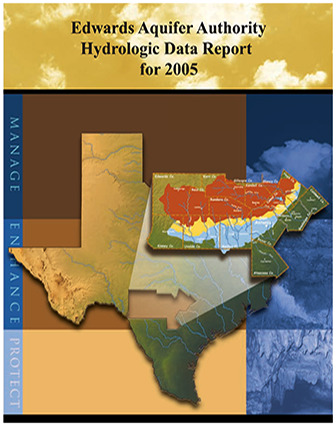Edwards Aquifer Authority Hydrologic Data Report for 2005

| Author | Hamilton M, Johnson S, Mireles J, Esquilin R, Burgoon C, Luevano G, Gregory D, Gloyd R, Sterzenback J, Mendoza R, and Schindel GM |
| Year | 2006 |
| Description | Annual report for 2005 on recharge, discharge, water levels and water quality in the Edwards Aquifer San Antonio Region |
| Report Number | 06-01 |
| Publisher | Edwards Aquifer Authority |
| Location | Edwards Aquifer - San Antonio Area |
| Cover | View Download |
| File | View Download |
| Summary |
|
This report presents the results of the Authority’s Edwards Aquifer Data Collection Program for calendar year 2005. … Water levels remained above the historical mean value at the Bexar County (J-17) index well throughout 2005. Other wells in the region exhibited similar behavior. In 2005 aquifer (groundwater) levels remained above historical mean values but generally decreased for most of the year. …Precipitation in the Edwards Aquifer region was below mean in 2005…. However, …rainfall in the drainage area (the northernmost counties in the region) was higher than that recorded within the recharge and artesian zones of the aquifer. … Total recharge to the Edwards Aquifer was 764,000 acre-feet in 2005, approximately 30 percent above the median of 585,700 acre-feet for the period of record (1934–2005). …In calendar year 2005, groundwater discharge from the Edwards Aquifer through wells and springs totaled 1,035,700 acre-feet. This amount is approximately 52 percent above the median of 681,500 acre-feet for the period of record (1934–2004). …Discharge from wells in 2005 was estimated to be 388,527 acre-feet, within approximately one percent of the 382,800 acre-foot ten-year median (1996–2005). …Discharge from springs in 2005 was estimated to be 647,146 acre-feet, approximately 32 percent more than the ten-year mean of 488,500 acre-feet. … For the period of record, 2005 experienced the second highest annual discharge from springs, exceeded only by the 1992 discharge value. Spring discharge for years 2005, 2004, 2003, and 2002 represents the second-, third-, fourth-, and fifth-highest discharge amounts for the period of record. … For well water samples collected in 2005, lead was detected at one location at 28.6 μg/L, well above the 15.0 μg/L MCL. Other metals detected include strontium, iron, and manganese at concentrations above their respective PCLs, or secondary standards. Surface and spring water sample analyses did not indicate the presence of any analyzed metals above their respective standards. For samples collected in 2005, nitrate-nitrite as nitrogen concentrations ranged from below the laboratory reporting limit of 0.015 mg/L to 7.34 mg/L in samples from wells, streams, and springs in the Edwards Aquifer region. …None of the samples collected exceeded the MCL of ten mg/L of nitrate as nitrogen. … One VOC was detected at or above its associated MCL in the 45 wells sampled. The compound tetrachloroethene (PCE) was detected at 30.5 μg/L in Bexar County well AY-68-36-1DR. The MCL for PCE is five μg/L. One additional VOC was detected in a well sample below the MCL in Bexar County. Several VOC compounds were detected in San Marcos Springs during the March and November sample events. In 2005, 25 wells and six spring groups were sampled for SVOC’s. The compounds phenol and n-nitroso-di-npropylamine were detected in well samples, whereas the compounds bis(2-ethylhexyl)adipate and benzoic acid were detected in spring water samples. In 2005, samples from 38 wells and six spring groups were analyzed for herbicides, pesticides, and PCB’s. No sample tested positive for these compounds. Edwards Aquifer water is generally of such high quality that it normally requires only chlorination to meet public drinking water standards. However, the detection of nitrates and organic compounds, as well as trace quantities of metals, in the aquifer is a concern, and the Authority will continue to monitor for these compounds to determine possible sources and trends. Nitrate as nitrogen was detected frequently in all sample types; however, well samples had the highest concentrations, with 31 of 95 wells sampled testing positive for nitrate-nitrite at 2.0 mg/L or higher. Five of the 95 wells had nitrate-nitrite concentrations above 5.0 mg/L; the MCL for nitrate-nitrite is 10 mg/L. … Confirmed detections of VOCs, such as PCE froma Bexar County well and 1,2,4-trimethylbenzene, xylene, and 1,2-dichloroethane at the San Marcos Springs, are a concern and warrant continued monitoring in the future. The Authority’s aquifer wide water-quality sampling program will continue to monitor wells, streams, and springs for indications of water quality impacts throughout the region. |
Search for Documents
Advance Search
Explore EAA's Scientific Reports
- All Reports
- Precipitation
- Overview Studies
- Modeling
- Hydrology and Hydrogeology
- History
- Groundwater Recharge, Recharge Zone
- Groundwater Movement
- Geomorphology and Caves
- Weather Modification
- Geology
- Water Use and Conservation
- Geochemistry
- Water Resources Planning and Management
- Floods and Drought
- Water Quality
- Climatology
- Surface Water / Groundwater Relationship
- Biology
- Springs, Groundwater Discharge
- Archaeology
- RZ Protection
- Aquifer Levels
- Remote Sensing
